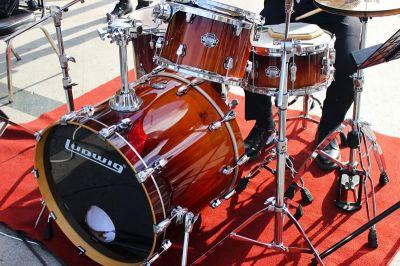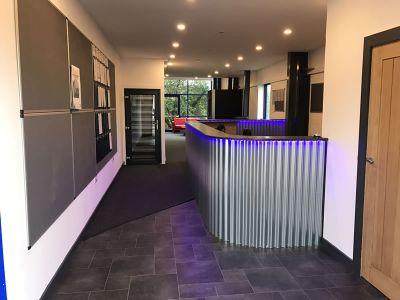Manufacturers of Vocal Booths
and Sound Isolation Enclosures
UK Freephone: 0800 170 1271
International: +44 (0) 7300 332 268
Email: Sales@kubevocalbooth.com
Follow Us:
Drum Booths & Drum Sound Isolation Enclosures

((( Check Out Our Isolation Drum Booths Here )))
Playing the drums is certainly a lot of fun but can be very challenging, especially if you have family members in the house or some neighbours.
Practising your drum skills will help you improve reflexes and tone your skills.
Apart from worrying about breaking your sticks the number one problem is noise. Most drummers love the experience of hitting the drums and cymbals as hard as possible to achieve the sound and vibrations they want to hear.
However, playing like a pro is going to upset your neighbours and possibly members of your family. If you want to keep your neighbours and family members happy and reduce the noise from your drum kit from the outside world you need one of our professional drum booths
Our modular drum sound booths will reduce drum bleed, noise breakout and low frequency reverberations whenever you practise. A medium sized drum booth will allow you to set up your entire drum kit and enable you to practise at any time. Each acoustic drum sound booth is supplied with specialist anti-vibration feet to prevent floor-borne sound transmission and a very high level of sound transmission reduction.
Our drum sound isolation enclosures are manufactured using fully tested acoustic panels which are available in various thicknesses and can be manufactured using either a single or double wall format for maximum noise reduction. Ideal for drum practice at home, our drum sound booths are an easy to build, acoustically designed sanctuary for the playing of musical instruments.
Our modular drum sound booths and drum practice rooms are manufactured by KUBE in house and as such any size or configuration can be manufactured to suit your requirements.
Our range of drum sound booths are easily installed and have been supplied to home users, professional drummers, music schools, universities and recording studios.
When setting up a sound isolation booth for drums, there are several key factors to consider. Here are the main things you should keep in mind:
Acoustic Treatment: The primary goal of a sound isolation booth is to minimize sound leakage in and out of the room. To achieve this, you need to ensure proper acoustic treatment within the booth. Use sound-absorbing materials such as acoustic panels, bass traps, and diffusers on the walls, ceiling, and floor to control reflections and reduce reverberation.
Soundproofing: In addition to acoustic treatment, you'll also need to focus on soundproofing to prevent sound from escaping or entering your practice space. The use of dense materials for construction, such as mass-loaded rubber and acoustic insulation, all create a barrier against sound transmission.

Kube Sound Isolation booths are designed to create a room within a room set up. This reduces the main sound impact and power ratio from the drum kit. The sound levels left over, outside the booth, are then reduced by your existing room. The main key to soundproofing is isolation from an outer construction (garage/room), also known as decoupling.
The better the outer room is sealed or treated for sound reduction the better your overall reduction levels will be.
For example – An acoustic drum kit on average outputs 110dB (equivalent to night club music). Our Silver Range Isolation Booth (mid-range) would reduce the output to around 75dB (equivalent to general traffic/vacuum cleaner). The power ratio difference is dramatic; however, the sound is still evident.
Your existing space now only needs to reduce the noise levels of a vacuum cleaner, which most house constructions and/or treated garage constructions would do easily. The result being an isolated space that allows you to practice and record without the fear of being too loud.
Understanding Sound Levels in Everyday Life
| dB Level | Examples | Power Ratio |
| 10 | Normal Breathing | 10 |
| 20 | Rustling Leaves - Distant | 100 |
| 30 | Whispering | 1000 |
| 40 | Library | 10,000 |
| 50 | Moderate Rain Fall | 100,000 |
| 60 | Normal Conversation | 1,000,000 |
| 70 | Traffic | 10,000,000 |
| 80 | Vacuum Cleaner | 100,000,000 |
| 90 | Shouting | 1,000,000,000 |
| 100 | Chainsaw | 10,000,000,000 |
| 110 | Night Club Music | 100,000,000,000 |
| 120 | Rock Concert | 1,000,000,000,000 |
| 130 | Threshold of Pain | 10,000,000,000,000 |
| 140 | Jet Engine at Take Off | 100,000,000,000,000 |
| 150 | Fire Works at 1m | 1,000,000,000,000,000 |
| 190 | Loudest Possible True Sound | 1.00E+19 |
Room Size and Shape: The size and shape of the booth will affect its acoustic properties. A larger room will generally provide better low-frequency absorption, while a smaller room might have more issues with standing waves. Consider the available space and choose a size that strikes a balance between practicality and optimal acoustics.
Decoupling/Isolation: As mentioned above, to further isolate the drums from the surrounding environment, decoupling techniques can be employed. This involves creating an air gap between the booth's walls, ceiling, and floor and the rest of the building structure. Specialized materials like resilient sound isolation clips and neoprene pads can be used in an existing room to achieve greater overall sound reduction.
Ventilation and Climate Control: Drums can generate a significant amount of heat and humidity, so proper ventilation and climate control are crucial. Install an efficient ventilation system to maintain airflow and prevent excessive heat build-up. All our booths come with passive, indirect passive ventilation ducts, which allow free flow of air inside the booth. The addition of our silent ventilation system will speed the air exchange rate by drawing stale air out of the booth, forcing fresh external air into the booth. There are two ways of controlling the temperature, depending on the use –
If you are not recording and only playing, a small, free standing HVAC unit can be placed inside the booth for direct cooling or heating, this can be ducted straight into our vent system.
If you are recording, the internal space (booth) will need to be free of unwanted noise and interference. Cooling/heating the existing room/space sufficiently (outside the booth) will ensure that the booth vent system will draw the temperature-controlled air into the booth, cooling or heating it through air exchange.
Access and Mobility: Consider the accessibility and mobility of the booth. Ensure there is enough space for the drummer to comfortably enter and exit, and for the drums to be set up and moved in and out. Portability is important, Kube Isolation Booths can be easily assembled and disassembled.
Equipment and Wiring: Plan for the placement of electrical outlets, audio cables, and other necessary equipment within the booth. Consider the layout of the drums, microphones, amplifiers, and any recording or monitoring devices you'll be using. Proper cable management is essential to avoid signal interference and maintain a clean and organized setup.
Ergonomics and Comfort: Lastly, prioritize the comfort and ergonomics of the drummer. Ensure there is enough space for proper drumming technique and movement. Pay attention to seating, lighting, and other factors that contribute to a comfortable and inspiring drumming environment.
By addressing these considerations, you can create a sound isolation booth that effectively contains the drum sound from the outside world, while providing a comfortable and functional space for drumming and recording.
Using a sound isolation booth for drums offers several advantages:
Noise Control: The primary benefit of a sound isolation booth is its ability to control and reduce noise. Drums can be very loud instruments, and by containing the sound within the booth, you can prevent it from disturbing others in the vicinity. This is particularly useful in residential areas or shared spaces where noise restrictions may apply.
Improved Recording Quality: A sound isolation booth provides a controlled acoustic environment, free from external noise and unwanted reflections. This allows for cleaner recordings with less bleed from other instruments or ambient sounds. It enables you to capture the true sound of the drums without interference, resulting in higher-quality recordings.
Enhanced Mixing and Production: When recording drums in an isolated environment, it becomes easier to mix and produce the tracks. The isolated sound allows for greater control over the individual drum tracks during the mixing process. It allows you to focus on capturing the desired tonal qualities, adjust the levels, and apply effects without interference from external factors.
Versatility and Flexibility: With a sound isolation booth, you have the flexibility to record drums at any time, regardless of the surrounding environment. You're not limited by noise curfews or disturbing others. This freedom allows for more creative exploration and the ability to capture inspiration whenever it strikes.
Improved Monitoring: In an isolated environment, monitoring becomes more accurate and reliable. You can hear the drum sounds more clearly without interference from external noise or room reflections. This helps the drummer and the recording engineer make informed decisions regarding the drum sound, dynamics, and performance.
Consistency in Performance: A sound isolation booth provides a consistent and controlled acoustic environment for drumming. This allows drummers to focus on their performance without being affected by external factors. The controlled sound environment enables consistent recordings and makes it easier to recreate specific drum sounds during subsequent sessions.
Protection of Equipment: Drums and their components can be delicate and sensitive to environmental conditions. Using a sound isolation booth helps protect the drums from potential damage caused by moisture, temperature fluctuations, or accidental impacts. It provides a controlled and safe space for storing and maintaining drum equipment.
Privacy and Concentration: Sound isolation booths provide privacy and allow drummers to concentrate on their playing without distractions. Whether for practice, rehearsals, or recording sessions, having a dedicated space where drummers can focus on their craft without external interruptions can greatly enhance their performance and productivity.
These advantages make a sound isolation booth an asset for drummers, recording engineers, and producers, as it facilitates improved sound quality, control, and creativity in drum recordings and performances.
To find out more about our acoustic drum sound booths please contact us FREE on 0800 170 1271 or pop an email through to Sales@kubevocalbooth.com and our friendly acoustic experts can advise on which drum sound booth would best suit your requirements.
Visit Our UK Showroom

Visiting our showrooms is a fantastic way to see at first hand the high quality of our drum booths and drum sound isolation enclosures.
Our purpose built showroom is located in Ripon, North Yorkshire. Apart from seeing our sound isolation products close up it really is a unique opportunity to discuss your requirements face to face and experience a sound reduction demonstration.
We can show you specific decibel (db) readings of both inside and outside our different sound booths.
A Few Of Our Clients